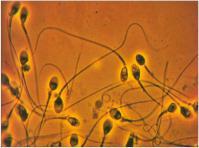There are no trucks in fertilization
Fight between two men for the female. It is written on the foundations of nature. At least on the basis of beings who follow a se-xuala reproduction. However, the story does not end there. To ensure reproduction, the winner of this conflict becomes a loser or for other known reasons, often a female can admit two or more males.

There have been numerous hypotheses about what happens when each male pours his sperm. One of them is the “kamikaze sperm hypothesis”, that is, that the aim of the sperm of the second fertilization is to end that of the previous one. The results of the latest research cast doubt.
Different solutions of nature
Females of many species are equated with many males in a very short time. Therefore, competition between hopes from different sources is frequent. Consequently, chimpanzees, for example, have developed larger dungeons to emit larger amounts of sperm. Some insects must kill the opponent's sperm before pouring it. The fruit fly puts poison in the competition spermatozoa.
Using large amounts and high mortality sperm, biologist Robin Baker of the University of Manchester, a decade ago, proposed that some mammals, including man, synthesized the "murdered sperm". His function was to attack the hope of others and thus commit suicide.
Biologist Harry Moore of Sheffield University and evolutionary ecologist Tim Birkhead wanted to confirm the correction of this hypothesis with another methodology. The sperm of 15 men mixed in many proportions and forms. Tracking cell movements and evolution and the appearance of strange forms. Finally, in the journal Proceedings of the Royal Society it was published that there were no indications of wrestling sperm or its consequences.
For Michael Bedford, who works at the prestigious Cornell University in New York State, this hypothesis of kamikaze sperm is totally wrong. However, as Birkhead says, more species will still have to be tested. As he explained, on issues of reproduction nature has taught us many times that "almost everything is possible".
Buletina
Bidali zure helbide elektronikoa eta jaso asteroko buletina zure sarrera-ontzian











